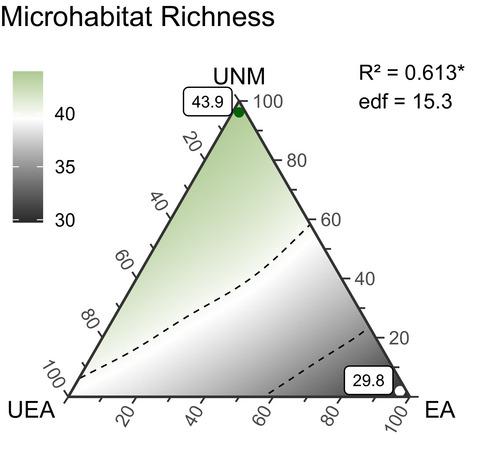当前位置:
X-MOL 学术
›
J. Appl. Ecol.
›
论文详情
Our official English website, www.x-mol.net, welcomes your feedback! (Note: you will need to create a separate account there.)
Among stand heterogeneity is key for biodiversity in managed beech forests but does not question the value of unmanaged forests: Response to Bruun and Heilmann-Clausen (2021)
Journal of Applied Ecology ( IF 5.7 ) Pub Date : 2021-08-31 , DOI: 10.1111/1365-2664.13959 Peter Schall 1 , Steffi Heinrichs 1 , Christian Ammer 1 , Manfred Ayasse 2 , Steffen Boch 3, 4 , François Buscot 5, 6 , Markus Fischer 4 , Kezia Goldmann 5 , Jörg Overmann 7 , Ernst‐Detlef Schulze 8 , Johannes Sikorski 7 , Wolfgang W. Weisser 9 , Tesfaye Wubet 10 , Martin M. Gossner 11, 12
中文翻译:

林分异质性是管理山毛榉森林中生物多样性的关键,但并不质疑未管理森林的价值:对 Bruun 和 Heilmann-Clausen 的回应(2021)
更新日期:2021-09-03
Journal of Applied Ecology ( IF 5.7 ) Pub Date : 2021-08-31 , DOI: 10.1111/1365-2664.13959 Peter Schall 1 , Steffi Heinrichs 1 , Christian Ammer 1 , Manfred Ayasse 2 , Steffen Boch 3, 4 , François Buscot 5, 6 , Markus Fischer 4 , Kezia Goldmann 5 , Jörg Overmann 7 , Ernst‐Detlef Schulze 8 , Johannes Sikorski 7 , Wolfgang W. Weisser 9 , Tesfaye Wubet 10 , Martin M. Gossner 11, 12
Affiliation

|
- Schall et al. (2020) assessed how a combination of different forest management systems in managed forest landscapes dominated by European beech may affect the biodiversity (alpha, beta and gamma) of 14 taxonomic groups. Current forest policy and nature conservation often demand for combining uneven-aged managed and unmanaged, set-aside for nature conservation, beech forests in order to promote biodiversity. In contrast to this, Schall et al. (2020) found even-aged shelterwood forests, represented by different developmental phases, to support highest regional (gamma) diversity.
- By pointing out that unmanaged forests included in our study are not old-growth forests, Bruun and Heilmann-Clausen (2021) challenge our conclusion as not providing sound scientific advice to societies. It is true that the studied unmanaged forests are not representing old-growth forests as defined in the literature. However, we demonstrate the representativeness of our unmanaged forests for current beech forest landscapes of Central Europe, where managed forests were more or less recently set-aside in order to develop old-growth structures. We also show that the managed and recently unmanaged forests in our study already differ distinctively in their forest structures.
- We use this response to stress the role of forest reserves for promoting certain species groups, and to emphasise their importance as valuable research sites today and in the future.
- Synthesis and applications. We see two main conclusions from our study. First, unmanaged forests still matter. We agree with Bruun and Heilmann-Clausen (2021) on the general importance of unmanaged, old-growth or long-untouched forests, and we do not question the importance of set-aside forests for biodiversity conservation. However, a complete complementarity to managed systems may only reveal after many decades of natural development. Second, safeguarding biodiversity in largely managed forest landscapes should focus on providing a landscape matrix of different developmental phases with varying environmental conditions rather than on maximising the vertical structure within stands. Such landscapes can partly compensate for structures that are still missing in vital, dense and closed forests recently set-aside or for unsuitable phases that may occur due to a cyclic synchronisation of forest structures in unmanaged forests.
中文翻译:

林分异质性是管理山毛榉森林中生物多样性的关键,但并不质疑未管理森林的价值:对 Bruun 和 Heilmann-Clausen 的回应(2021)
- 沙尔等人。(2020) 评估了在以欧洲山毛榉为主的管理森林景观中不同森林管理系统的组合如何影响 14 个分类群的生物多样性(alpha、beta 和 gamma)。当前的森林政策和自然保护往往需要将不均匀年龄的管理和未管理的、为自然保护预留的山毛榉林相结合,以促进生物多样性。与此相反,Schall 等人。(2020) 发现以不同发展阶段为代表的等龄防护林支持最高的区域 (gamma) 多样性。
- Bruun 和 Heilmann-Clausen(2021)指出我们研究中包括的未管理森林不是原始森林,因此质疑我们的结论,因为它没有向社会提供合理的科学建议。确实,所研究的未管理森林并不代表文献中定义的原始森林。然而,我们展示了我们的未管理森林对中欧当前山毛榉森林景观的代表性,那里管理的森林或多或少最近被搁置,以发展古老的生长结构。我们还表明,我们研究中的管理和最近未管理的森林在森林结构上已经明显不同。
- 我们利用这种反应来强调森林保护区在促进某些物种群体方面的作用,并强调它们作为当今和未来有价值的研究地点的重要性。
- 合成与应用. 我们从我们的研究中看到两个主要结论。首先,未管理的森林仍然很重要。我们同意 Bruun 和 Heilmann-Clausen(2021)关于未管理的、古老的或长期未开发的森林的普遍重要性的观点,并且我们不质疑预留森林对生物多样性保护的重要性。然而,管理系统的完全互补性可能只有在经过几十年的自然发展后才能显现出来。其次,保护大规模管理的森林景观中的生物多样性应侧重于提供具有不同环境条件的不同发展阶段的景观矩阵,而不是最大化林分内的垂直结构。这样的景观可以部分补偿重要的结构仍然缺失,



























 京公网安备 11010802027423号
京公网安备 11010802027423号